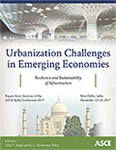ASCE India Conference 2017
Developing a Sustainable Building Assessment Tool (SBAT) for Developing Countries—Case of India
Publication: Urbanization Challenges in Emerging Economies: Resilience and Sustainability of Infrastructure
ABSTRACT
The rapid building infrastructure development consumes natural/non-renewable resources, generate waste, and releases potentially hazardous emissions into atmosphere affecting the environment, social, economic, and technological aspects (sustainable indicators) throughout their whole life-cycle. This necessitates assessment of the degree of sustainability of the building in developing countries like India considering local context, topography, climatic variations, and regional differences. The comparitive study on most widely used existing assessment tools like LEED, GRIHA, IGBC, and BREEAM reveals that there are some limitations when applied to Indian context. The objective of the study is to quantify and assess the performance of new and existing buildings towards sustainability by interrelating the sustainable indicators and their criteria. This evaluation approach provides a deep insight into developing a sustainable building assessment tool (SBAT), which can be referred and recommended in assessing the sustainable building performance compared to various available tools. The developed holistic framework will facilitate the decision makers/stakeholders to improve the sustainable performance of buildings in developing countries like India.
Get full access to this article
View all available purchase options and get full access to this chapter.
REFERENCES
The Associated Press. (2008). UN says half the world’s population will live in urban areas by end of 2008. International Herald Tribune. http://www.iht.com/articles/ap/2008/02/26/news/UN-GEN-UN-Growing-Cities.php.
Alyami, S. H., & Rezgui, Y. (2012). “Sustainable building assessment tool development approach.” Sustainable Cities and Society, 5(1), 52-62. https://doi.org/10.1016/j.scs.2012.05.004
Alyami, S. H., Rezgui, Y., & Kwan, A. (2015). The development of sustainable assessment method for Saudi Arabia built environment: weighting system. Sustainability Science, 10(1), 167-178. https://doi.org/10.1007/s11625-014-0252-x
Banani, R., Vahdati, M. M., Shahrestani, M., & Clements-Croome, D. (2016). “The development of building assessment criteria framework for sustainable non-residential buildings in Saudi Arabia.” Sustainable Cities and Society, 26, 289-305. https://doi.org/10.1016/j.scs.2016.07.007
Berardi, U. (2015). “Building Energy Consumption in US, EU, and BRIC Countries.” Procedia Engineering, 118, 128-136. https://doi.org/10.1016/j.proeng.2015.08.411
Bhatt, R., Bhatt, D., & Patel, V. (2010). “Analytic Hierarchy Process Approach for Criteria Ranking of Sustainable Building Assessment : A Case Study.” World Application Science, 8(7), 881-888.
Boutkhoum, O., Hanine, M., Boukhriss, H., Agouti, T., Tikniouine, A., Ageron, B., Peng (2016). “Multi-criteria decision support framework for sustainable implementation of effective green supply chain management practices.” SpringerPlus, 5(1), 664. https://doi.org/10.1186/s40064-016-2233-2
Cole, R. J. (2005). “Building environmental assessment methods: redefining intentions and roles.” Building Research & Information, 33(5), 455-467. https://doi.org/10.1080/09613210500219063
Ding, G. K. C. (2007). “Life cycle assessment (LCA) of sustainable building materials: an overview", Building Research & Information, 1-20.
Economic Policy Forum. (2014). Promoting sustainable and inclusive growth in emerging economies : Green Buildings, 1-62. Retrieved from https://economic-policy-forum.org/wp-content/uploads/2016/02/Sustainable-and-Inclusive-Growth-Green-Buildings.pdf
Horvat, M., & Fazio, P. (2005). “Comparative Review of Existing Certification Programs and Performance Assessment Tools for Residential Buildings.” Architectural Science Review, 48(1), 69-80. https://doi.org/10.3763/asre.2005.4810
IGBC Green New Rating Sytem version 3.0. (2015). Abridged Reference Guide, 146.
Jain, M., Mital, M., & Syal, M. (2013). “Obstacles and Catalysts Associated with Implementation of LEED-EB(R) in India.” Environment and Urbanization Asia, 4(2), 349-363. https://doi.org/10.1177/0975425313511164
Korkmaz, S., Erten, D., Syal, M., & Potbhare, V. (2009). “A review of green building movement timelines in developed and developing countries to build an international adoption framework.” In Proceedings of Fifth International Conference on Construction in the 21st Century: Collaboration and Integration in Engineering, Management and Technology (pp. 20-22).
Mao, X., Lu, H., & Li, Q. (2009). “A comparison study of mainstream sustainable/green building rating tools in the world. Proceedings - International Conference on Management and Service Science, MASS 2009. https://doi.org/10.1109/ICMSS.2009.5303546
McCormick, K., Anderberg, S., Coenen, L., & Neij, L. (2013). “Advancing sustainable urban transformation.” Journal of Cleaner Production, 50, 1-11. https://doi.org/10.1016/j.jclepro.2013.01.003
Saaty, T. L. (2008). "Decision making with the analytic hierarchy process". International Journal of Services Sciences, 1(1), 83. https://doi.org/10.1504/IJSSCI.2008.017590
Sev, A. (2011). “A comparative analysis of building environmental assessment tools and suggestions for regional adaptations.” Civil Engineering and Environmental Systems, 28(3), 231-245. https://doi.org/10.1080/10286608.2011.588327
Singh, S., Lal, R. B., Sridharan, U., & Upadhyay, V. P. (2016). “Environmental Sustainability Guidelines for Green Buildings in India: A Review.” Indian Journal of Scientific Research and Technology, 4(1), 2321-9262. Retrieved from www.indjsrt.com
Smith, R. M. (2015). “Green building in India: A comparative and spatial analysis of the LEED-India and GRIHA rating systems.” Asian Geographer, 32(2), 73-84. https://doi.org/10.1080/10225706.2015.1020065
Tathagat, D., & Dod, R. D. (2015). “Role of Green Buildings in Sustainable Construction-Need, Challenges and Scope in the Indian Scenario". IOSR Journal of Mechanical and Civil Engineering Ver. II, 12(2), 2320-334. https://doi.org/10.9790/1684-12220109
USGBC. (2016). LEED v 4 for Neighborhood Development, 161. Retrieved from http://www.usgbc.org/sites/default/files/LEEDv4BDC_04.05.16_current.pdf
Vij, A., Shorey, G., Zia, H., Majumdar, M., Shukla, P., Kumar, P., Tripathi, A. K. (2010). GRIHA Manual, 1, 129. Retrieved from ttp://www.grihaindia.org/files/Manual_VolI.pdf
Vyas, G. S., & Jha, K. N. (2016). “Identification of green building attributes for the development of an assessment tool: a case study in India.” Civil Engineering and Environmental Systems. https://doi.org/10.1080/10286608.2016.1247832
Information & Authors
Information
Published In
Urbanization Challenges in Emerging Economies: Resilience and Sustainability of Infrastructure
Pages: 137 - 148
Editors: Udai P. Singh and G. L. Sivakumar Babu, Indian Institute of Science
ISBN (Online): 978-0-7844-8203-2
Copyright
© 2018 American Society of Civil Engineers.
History
Published online: Dec 13, 2018
Authors
Metrics & Citations
Metrics
Citations
Download citation
If you have the appropriate software installed, you can download article citation data to the citation manager of your choice. Simply select your manager software from the list below and click Download.
